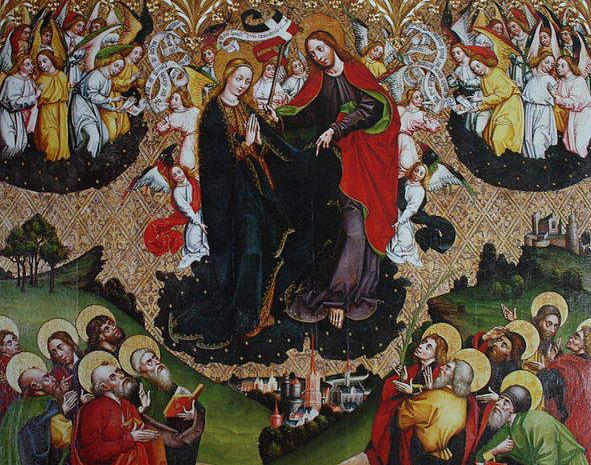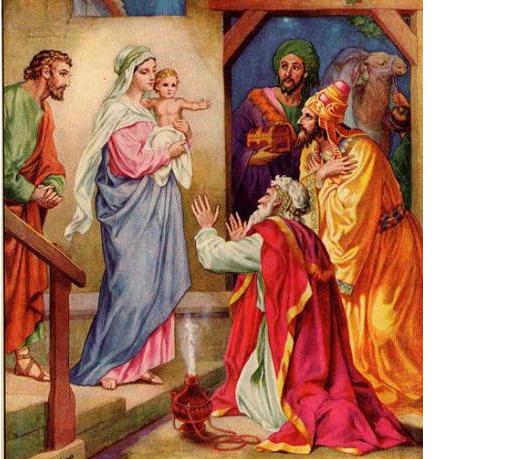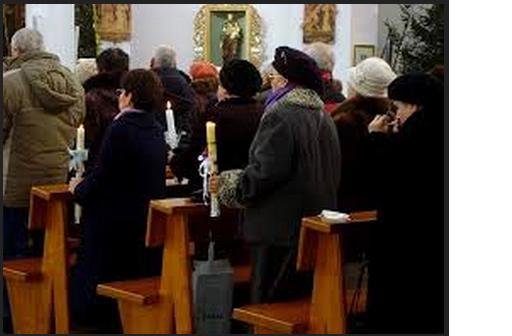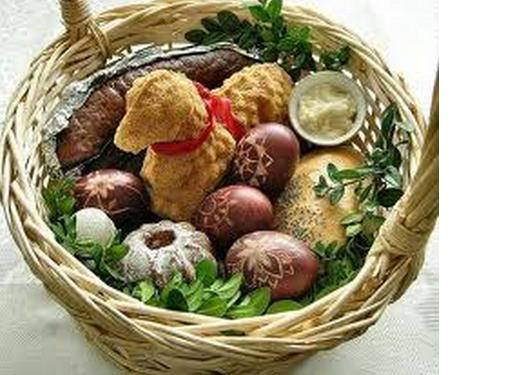” The joy of brightening other lives, bearing each other’s burdens, easing other’s loads and supplanting empty hearts and lives with generous gifts becomes for us the magic holidays” – W. C. Jones
January
January 1st: Nowy Rok- New Year’s Day
It is a public holiday. People usually spend it relaxing at home, going to church and restaurants (in bigger cities).
January 6th: Trzech Króli (Objawienie Pańskie) Epiphany
It is a non-working public holiday to celebrate Epiphany, which was re-established as a non-working public holiday in 2011 by the act of Parliament. The main tradition of that day are parades to commemorate the journey of the Wise Men to Jesus’ place of birth. It involves dressing as Wise Men, passing out sweets, singing carols and presenting living nativity scenes. Also the priests bless houses of Roman Catholics by inscribing “C+M+B+” (Christus Mansionem Benedicat- the house blessing) and the year with the blessed chalk on the main door.
January 21st: Grandmother’s Day
On this day people visit their grandmas or send them wishes and flowers.
January 22nd: Grandfather’s Day
Celebrated similarly to Grandmother’s Day.
February
February 2nd: Ofiarowanie Pańskie (Matki Boskiej Gromnicznej)- Feast of Our Lady of Thunder candles.
The name refers to the candles that are blessed on this day, called gromnice, since these candles are lit during thunder storms and placed in windows to ward off storms. On on the 2nd of February priests bless candles for use throughout the year. Sometimes they are distributed to the faithful for use at home.This Christian holiday is also known as Candlemass. It is not a public holiday.
February 14th: Walentynki- Valentine’s Day
It is celebrated in the same way as in other countries: couples go to restaurants and buy each other gifts. Teenagers who are secretly in love with each other are encouraged to express their feelings in love letters.
A movable holiday, the last Thursday before Lent: Tłusty Czwartek- Fat Thursday
It starts the last week of Carnival. It is allowed to gorge oneself, particularly with doughnuts and faworki. For this reason doughnuts are sold in every store in large amounts. Companies and schools often purchase doughnuts for their employees and students. It is commonly believed that a person who does not eat a doughnut on fat Thursday will be doing badly for the entire year.
March
The last Saturday of Carnival: Narodowy Dzień Pamięci Żołnierzy Wyklętych– National Day of Remembrance of Soldiers accursed.
Accursed Soldiers are those who took part in Polish resistance movements during the WW2 and later on. They were eventually eliminated in the 1950’s by the Communist government. Although it is not a major holiday, many cities organize concerts, marches, exhibitions and other cultural events to commemorate people involved in independent military activities which aimed to return human rights in Poland. These events are usually accompanied by masses at church, speeches and meetings of combatants.
Click here to find out more about this holiday
Movable holiday determined by Easter: Ostatki- Shrove Tuesday
It is the last day of Carnival. Although there are no celebrations organized on that day, more recently going out to night clubs has become common.
Determined by Easter: Popielec- Ash Wednesday
It is an important Christian church holiday as it is the first day of Lent and a day of strict fasting. Its most significant tradition is the mass during which people’s foreheads are marked with ash. The ash comes from holy palms burned after Palm Sunday. Pope John Paul 2 encouraged people to pray for peace on Ash Wednesday.
March 8th: International Women’s Day
This holiday used to be celebrated on a larger scale during communism than it is nowadays. It was due to the fact that it was based on the demonstration organized by women belonging to Social- Democratic organization… paradoxically, in the United Sates. Nowadays some people still maintain its main tradition of giving women flowers.
March 10th: Men’s Day
It is a relatively new holiday on which women wish men all the best.
March 21st: First Day of Spring
It derives from Ostara – a pagan holiday, celebrated on March 21, to celebrate a joyful moment of equality of day and night. It is also connected with Jare Holiday. The latter is the ethnic holiday of Slavs. One of its main traditions has remained until nowadays. It involves making a straw effigy (called Marzanna), burning it and throwing it in a river, which is commonly done by school children.
April
April 1st: Prima Aprilis
It could be called a holiday of jokes. Although it is not treated as a classic holiday, it is important to remember about it to avoid becoming a victim of a cruel joke!
Movable holiday, Sunday before Easter: Niedziela Palmowa- Palm Sunday
It is a Christian holiday to commemorate the entry of Jesus into Jerusalem. The decorated twigs and flowers that people bring to the mass (or procession) symbolize the palms that the crowds welcomed Jesus with. People across Poland organize competitions for the most beautiful bouquets.
Holy Week- its dates are movable:
| Wielki Czwartek– Holy Thursday- it is the fifth day of Holy Week. Although schools do not operate on Holy Week, most of the companies do not stop their operations until the eve of Easter. |
| Wielki Piątek– Good Friday for Christian people is traditionally established as the time for strict fasting and prayer. Many parishes hold Way of the Cross processions.Click here to see the Cross Procession held in Gdańsk |
Wielka Sobota– Holy Saturday- there is always a bit of turmoil in many houses on Holy Saturday. This is because most of the cooking and cleaning takes place then. Holiday preparations have to be well coordinated with Easter traditions: eggs must be painted, the sugar lamb along with food samples have to sit in the basket and be ready to be taken by children to church for blessing.
|
| Wielkanoc– Easter Sunday- Its most important meal is breakfast. For Christians the Easter mass is of the crucial importance- Resurrection of Christ and the beginning of spring epitomize new life and make the holiday a happy time. |
| Poniedziałek Wielkanocny– Easter Monday- It is a non-working public holiday. It is also called Wet Monday/Dyngus Day. According to the old tradition (which is probably of a pagan origin) men splash water o women and the next day women do the same to men. It was believed that the girl who does not get wet on Wet Monday will not get married. |
April 22nd: Międzynarodowy Dzień Ziemi- The Earth Day
Events that take place during this day are the same across the world, including Poland. Many schools organize trash picking activities for children.
Movable holiday- depends on Easter: Święto Miłosierdzia Bożego- The Divine Mercy Sunday
It is a church holiday celebrated on the first Sunday after Easter.
May
May 1: Międzynarodowe Święto Pracy- International Labor Day
It is a working class celebration which is a non-working public holiday. This holiday has its roots in events that took place in Chicago in the 80’s to commemorate the labor demonstrations against the 8-hour working day.
May 2nd: Dzień Flagi Rzeczypospolitej Polskiej- Polish Flag Day
A holiday introduced in 2004, it commemorates raising the flag on Siegessäule during the Battle of Berlin.
May 3rd: Święto Konstytucji 3 Maja- The Constitution of 3rd May
It is a public holiday. The reason why it is an important day in Poland is that its aim was to repair the destructive political system (Liberum Veto) existing at that time in Poland. It was also the world’s second oldest national constitution after the US constitution.
May 26th: Dzień Matki- Mother’s Day
On this special day mothers receive wishes, flowers, chocolate and special gifts.
June
June 1st: Międzynarodowy Dzień Dziecka- International Children’s Day
This holiday was originally established as a symbol of protection of children. In Poland parents buy their children toys and sweets and some companies hand out packages with sweets for the employees’ families. There are also some concerts and events organized for children in various towns.
Movable holiday (between April and June): Wniebowstąpienie- Feast of the Ascension
The holiday takes place on Sunday around 40 days after Easter. It is one of the oldest and most important holidays in the Christian church as it commemorates the Jesus’ ascension to Heaven.
May/June, movable on Sunday: Zesłanie Ducha Świętego ,also called Zielone Świątki-Pentecost
Originally, it was a feast in ancient Israel. In the Christian liturgical year, it became a feast commemorating the descent of the Holy Spirit upon the Apostles and other followers of Jesus.The name Zielone Świątki comes from the pagan holiday that took place around the same time in Poland, and involved driving out water demons responsible for spring vegetation.
A Thursday in June: Boże Ciało- Corpus Christi Feast
This is a major Catholic holiday and a non-working public holiday. It is celebrated across Poland by all of the parishes which prepare decorated alters around churches and in some communities. Then processions from alter to alter take place. It celebrates the belief in the real presence of the Body of Jesus in the Eucharist. It refers to Holy Thursday for its nearness to Holy Friday. The video below shows a procession in the city of Sanok.
June 21: Pierwszy Dzień Lata – First Day of Summer
It is not a holiday, however, it is a significant day for it is the first day of summer and the longest day of the year.
June 23rd: Dzień Ojca- Father’ Day- celebrated similarly to Mother’s Day
August
August 1st: Narodowy Dzień Pamięci Powstania Warszawskiego– National Rememberance Day of Warsaw Uprising
This day commemorates the major World War II operation by the Polish resistance Home Army which aimed to liberate Warsaw from Nazi Germany. The significance of this uprising stems from the fact that it resulted with a large number casualties and further destruction of Warsaw which had already been grazed to the ground in the most part. The short animation Hardkor 44 by a famous Polish animator Tomasz Bagiński aims to present this dramatic operation ( click here to read the exclusive interview with Tomasz Bagiński ).
August 15: Święto Wojska Polskiego- Armed Forces Day
It commemorates the anniversary of the 1920 victory over Soviet Russia at the Battle of Warsaw during the Polish-Soviet War. A holiday barred during the communist era, nowadays it is celebrated across Poland in the form of military parades with the largest one taking place in the capital city of Warsaw.
The holiday is held along with another public Catholic holiday Wniebowzięcie Najświętszej Maryi Panny- Assumption of the Virgin Mary – which refers to the dogma that Saint Mary was bodily taken to heaven at the end of her earthly life.

Painting from 1480 by Jan Wielki showing Assumption of the Virgin Mary- currently at the church in Warta (Łódź area)
August 31: Dzień Solidarności i Wolności- The Day of Solidarity and Freedom
It is set on the anniversary of August Agreement from 1980- the result of the strikes and the Solidarity movement.The Agreements’ main point was accepting free trade unions independent of the Communist Party and of enterprises.
September
September 23rd: Początek Astronomicznej Jesieni- the beginning of astronomical autumn
October
October 14th: Dzień Nauczyciela- it is the Teacher’s Day which is also called the Day of National Education. It is celebrated at schools by giving speeches, performances and handing flowers to teachers.
November
November 1st: Wszystkich Świętych- All Saints Day
It is a Catholic holiday commemorating all those who have attained the beatific vision in Heaven. Its tradition also involves taking flowers to the graves of relatives and lighting candles. It is a non-working public holiday in Poland.
November 2nd: Dzień zaduszny (or Zaduszki)-The Day of the Dead
A non-working national holiday. It originates from the Slavic pagan holiday Dziady. On the eve of Dziady most of the rituals took place, such as leaving the doors and windows open to let the souls of the dead in.
November 11th: Narodowe Święto Niepodległości- National Independence Day
It is a public non-working holiday celebrated to commemorate regaining the independence by the Polish Nation in 1918 after 123 years of the partition of Poland by the Russian Empire, Prussian Kingdom and the Habsburg Empire.
November 29th: Andrzejki- St.Andrew’s Day
A holiday celebrated in the evening. Traditionally, the celebration involves various future-telling games, but more recently it is limited to house parties and clubbing.

Pouring hot wax through a keyhole into cold water and recognizing the meaning of formed shape is one of the holiday’s future telling activities. The shape of the piece of wax formed is analyzed by looking at its shadow.
December
December 4th: Barbórka- Saint Barbara’s Day
The day of miners. It was originally the day St. Barbara who was a patron of miners and other professionals working with explosive materials.
December 6th: Mikołajki- Saint Nicholas’ Day
It is the day of Saint Nicholas who was the 4th century Christian Bishop. He had a reputation for secret gift-giving which made him the model for Santa Claus. Parents usually put small gifts or sweets under children’s pillows where they can be found in the morning.
December 21st: beginning of the astronomical winter and the shortest day in the year.
December 24th: Wigilia Bożego Narodzenia- Christmas Eve.
Although it is considered as the beginning of Christmas and the supper is eaten in a festive way and gifts are opened, most people have to work until early afternoon.
Click here to read more about the Christmas Eve’s culinary traditions
Click here for a detailed description of other traditions of the Christmas Eve
December 25th: Boże Narodzenie- Christmas
A commemoration of the birth of Jesus Christ. It is a non-working public holiday. Although it is a Christian holiday, it is also celebrated in a secular way. Apart from participating in the mass, it involves spending time with family, decorating houses and the Christmas tree with lights, cooking Christmas meals and gifts-giving.
December 26th: Świętego Szczepana- Saint Stephen’s Day
It is the second day of Christmas and a non-working public holiday. Many clubs and restaurants organize a party called Szczepanówka on that day. Saint Stephen was the first Christian martyr.
The period between Christmas and Ash Wednesday is called Zapusty (an equivalent of Carnival). Nowadays it is mostly associated with fancy-dress parties, but this tradition in Poland originates from dressed up carolers.
Carolers are groups of dressed-up men, never women, who visit houses on Christmas with good wishes and very often give a performance. The tradition of caroling has been cultivated in Poland for a very long time. Formerly, caroling was a magic practice. The caroler’s ritual behavior, their puppets and costumes had a symbolic meaning and were supposed to bring the fulfillment of wishes.The oldest form of caroling, having their origin in pre-Christian times, involves animal puppets. They usually represent a he-goat , a she-goat, a bull called turoń a mare, a horse, a stork and a rooster, which symbolize the sun, revival, fertility and vitality. To increase the efficacy of the animal puppets, characters mediating between man and supernatural beings accompany them. In the Polish folk culture this mediating role has been adopted by creatures from the border lines, for example, by the devil and the death from the border line between the human and the divine, by the bride and the bridegroom from the border line between the statuses of single and married people, by an old couple from the border line between life and death and by a multitude of people ethnically, culturally and professionally “foreign”, such as a Gypsy, a Jew, a peddler or a policeman operating on the border line between the local community and the outside world.
The carolers’ dresses were made of straw, fur and horns, which signified abundance and fertility. A wooden head of an animal was stuck on a long stick, which the caroler thrust out from under a sheet or a sheepskin that covered his body. Masks made their costumes complete. Later on many forms of caroling have been inspired by medieval mystery plays. Those still popular all over Poland are: a performance called Herody, caroling with a crib, caroling with a Bethlehem star and caroling of the Three Kings. Those forms of caroling are interesting examples of a combination of the old liturgical drama and morality plays on the one hand, and the folk tradition of the caroling on the other.
A unique phenomenon is the Polish puppet crib. It is the only one to contain not only Nativity-play characters, but also a stage where puppets give a performance, which blends classical motifs of the Nativity with purely secular satirical motifs pertaining to manners. The custom was very popular in 19th century Poland, both in town and village. In the 20th century the custom has been preserved only in the countryside. The city of Kraków where the art of rib making has flourished and survived until this day has been a notable exception. The great success of the Kraków crib could be partly attributed to its imitation of the city’s ancient architecture.
To keep the tradition of crib-making the town’s authorities organized a competition for the most beautiful Kraków’s crib. The first one was held in the main city market in December 1937. The contest has been held in the same place until this day. It gave a birth to a new kind of the Kraków crib, known as contest crib. Its maker gives all his attention to architectural and aesthetic values of the building. Always, however, both the mass of the crib as well as its architectural details, built of wooden lists, cardboard and colored tin foil, is modeled on the authentic ancient buildings of Kraków.
/The photos and the information about cribs comes from the ethnic museum in Kraków/
December 31st: Nowy Rok- New Years Eve
It is an ordinary working day. The eve of the New Year is celebrated by attending parties or concerts on cities’ market squares, watching fireworks, a midnight countdown and drinking champagne.
















dobre zestawienie, chyba żaden blog wcześneij tego nikomu po angielsku nei podał 😀
Dziekuje, taka mala, a byc moze przydatna porcja wiedzy
Pingback: TODAY’S HOLIDAY: POLISH CONSTITUTION DAY | euzicasa